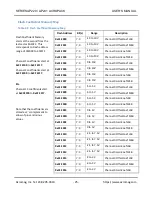
SERIES AP220 / AP231 ACROPACK
USER
’S MANUAL
Acromag, Inc. Tel: 248-295-0310
- 36 -
http://www.acromag.com
- 36 -
https://www.acromag.com
Table 6.5 PCIe Bus Data Rates
PCIe Gen 1 (1 lane)
Giga bit / second
Bytes / second
Signaling Rate
2.5 Gb/s
312 Mbyte/s
Ideal Rate
1
2 Gb/s
250 Mbyte/s
Header Burden plus 4byte
Sample Rate
2
0.332 Gb/s
41.6 Mbyte/s
Actual Measured 4 Byte
Read Rate
3
0.019 Gb/s
2.35 Mbytes/s
Actual Measured DMA 4
Byte Read Rate
4
0.327 Gb/s
40.9 Mbyte/s
Actual Measured 4 Byte
Write Rate
5
0.320 Gb/s
40 Mbyte/s
Note 1:
PCIe x1 Gen 1 = 2.5GT/s (with 10-bit encoding we have a 20% loss in
possible throughput due to encoding) giving 2.0 G bits/sec or 250M Bytes/sec.
Note 2:
With PCIe we have a header for address and read/write command that is
sent with every packet. This header is 20 Bytes with data payload of 4 Bytes (for our
typical AcroPack). For each 4 Byte data sample, 24 Bytes are sent.
250𝑀𝐵𝑦𝑡𝑒/𝑠
24
𝐵𝑦𝑡𝑒𝑠
=
10.4 M samples/sec or 41.6 M Bytes/sec or 0.332 G bit/sec
Note 3:
For our typical AcroPack have measured back to back 4 Byte read
operations completing every 1.7usec. A read operation starts with a host read
request. The AcroPack must process the read and fetch the data and then generated
the completion back to the host. The host then sends a message back that says I got
it. This back and forth hand shaking slows down individual reads.
Note 4:
DMA Read of 1024 sample takes 100us. Each sample is 4 Bytes.
100us/1024=0.0977us per sample or 4/0.0977us = 40.94Mbyte/s. We use DMA
transfers to improve data transfers on the AP341/2 and AP225/235.
Note 5:
Simple write operations are just as fast as DMA read operations. Write
data is presented to the AcroPack in one transaction. Measured 4-byte back to back
write accesses taking place every 100ns.






































